Angkor Wat
(Cambodia)
Some pictures from my trip to Indochina in June 2007
Angkor Wat is the largest religious building in the world.
It was built for King Suryavarman II in the early 12th century as his state temple and capital city.
As the best-preserved temple at the site, it is the only one to have remained a significant religious centre
since its foundation—first Hindu, dedicated to Vishnu, then Buddhist.
The temple is the epitome of the high classical style of Khmer architecture.
It has become a symbol of Cambodia, appearing on its national flag,
and it is the country's prime attraction for visitors.
Angkor Wat combines two basic plans of Khmer temple architecture
- the temple mountain and the later galleried temple.
It is designed to represent Mount Meru, home of the gods in Hindu mythology.
Within a moat and an outer wall 3.6 km long are three rectangular galleries, each raised above the next.
I got up at 4.30am in order see the sunrise at Angkor Wat.
I walked acrosss the causeway over the moat in the dark.
It was a great sight seeing Angkor Wat emerge from the darkness.
There were lots of tourists up early too.
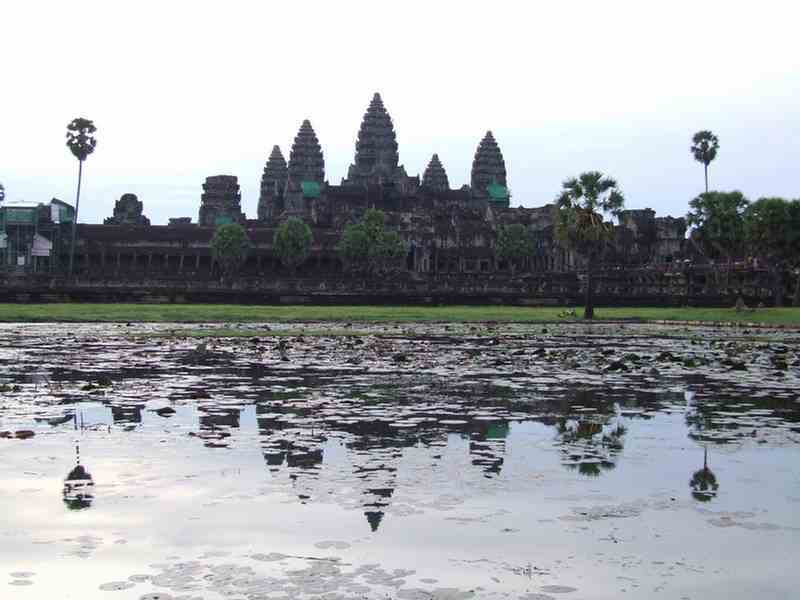
In the 14th or 15th century the temple was converted to Theravada Buddhist use, which continues to the present day.
Angkor Wat is unusual among the Angkor temples in that although it was somewhat neglected after the 16th century
it was never completely abandoned, its preservation being due in part to the fact that its moat also provided some
protection from encroachment by the jungle.
Angkor Wat is the prime example of the classical style of Khmer architecture
(the Angkor Wat style) to which it has given its name.
By the 12th century Khmer architects had become skilled and confident in the use of sandstone
(rather than brick or laterite) as the main building material.
Most of the visible areas are of sandstone blocks, while laterite was used for the
outer wall and for hidden structural parts.
The binding agent used to join the blocks is yet to be identified,
although natural resins or slaked lime have been suggested.
The towers are shaped like lotus buds. The temple stands on a terrace raised higher than the surroundings.
The central tower rises 31m above the third level and 55m above the ground.
I was able to climb to the third level.
The very steep stairways represent the difficulty of ascending to the kingdom of the gods.
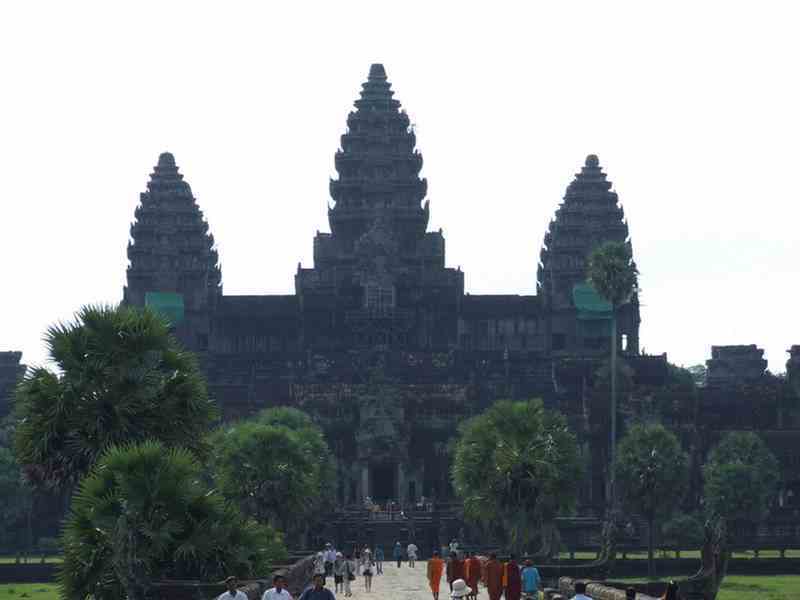
There are lots of galleries of sculptures on the walls.
The sculptures depict battles and scenes from daily life.
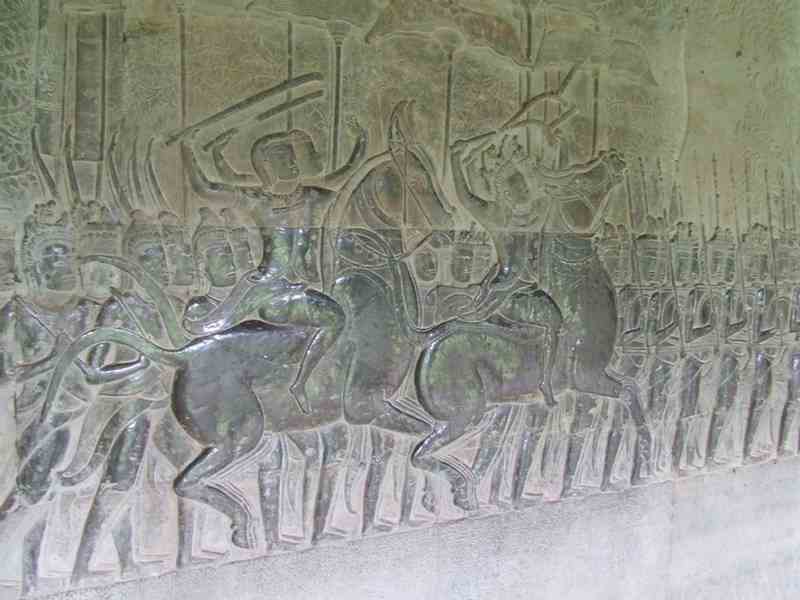
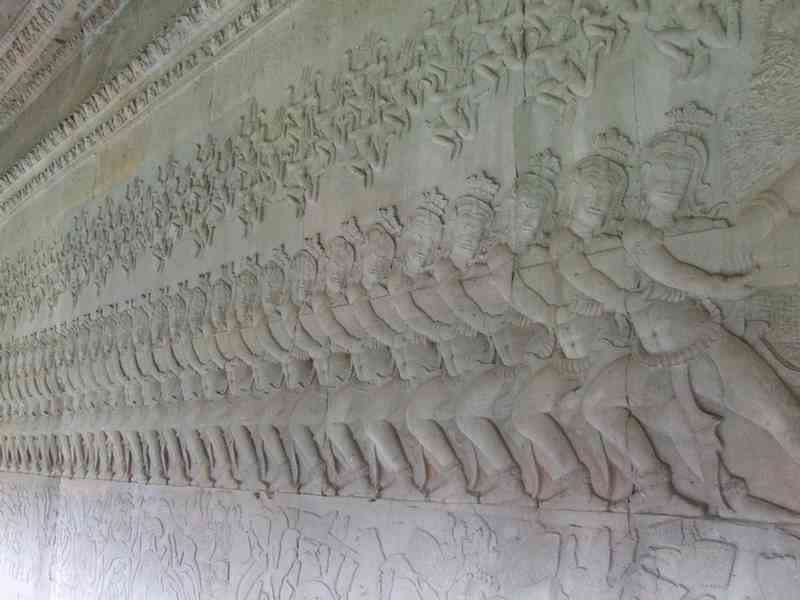
There are nearly 2000 distinctively rendered apsara carvings
(Hindu female spirit of the clouds and waters).
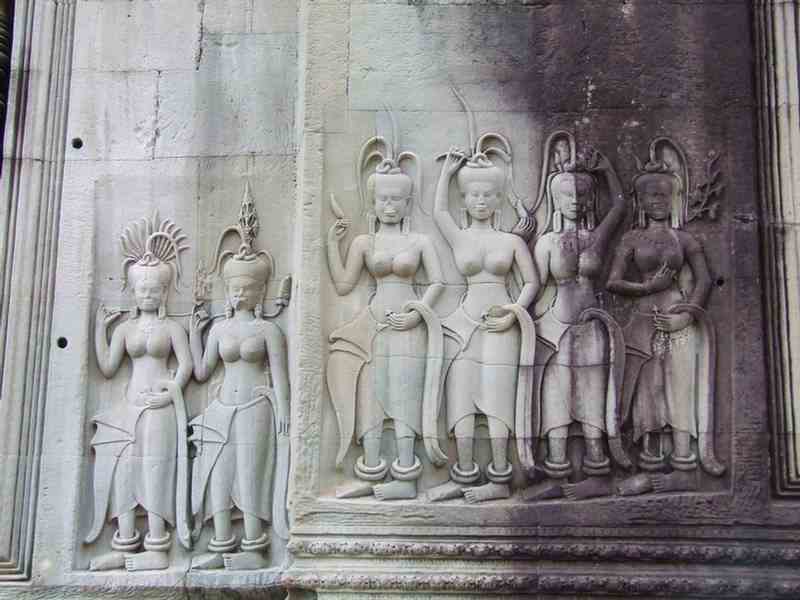
During half-millennia of Khmer occupation, the city of Angkor became a pilgrimage destination
of importance throughout Southeastern Asia.
Sacked by the Thais in 1431 and abandoned in 1432, Angkor was forgotten for a few centuries.
Wandering Buddhist monks, passing through the dense jungles, occasionally came upon the awesome ruins.
Recognizing the sacred nature of the temples but ignorant of their origins,
they invented fables about the mysterious sanctuaries,
saying they had been built by the gods in a far ancient time.
Centuries passed, these fables became legends,
and pilgrims from the distant reaches of Asia sought out the mystic city of the gods.
A few adventurous European travellers knew of the ruins and stories circulated in
antiquarian circles of a strange city lost in the jungles.
Most people believed the stories to be nothing more than legend however,
until the French explorer Henri Mouhot brought Angkor to the world's attention in 1860.
The French people were enchanted with the ancient city and beginning in 1908
funded and superbly managed an extensive restoration project.
The restoration has continued to the present day, excepting periods in the 70's and 80's
when military fighting prevented archaeologists from living near the ruins.
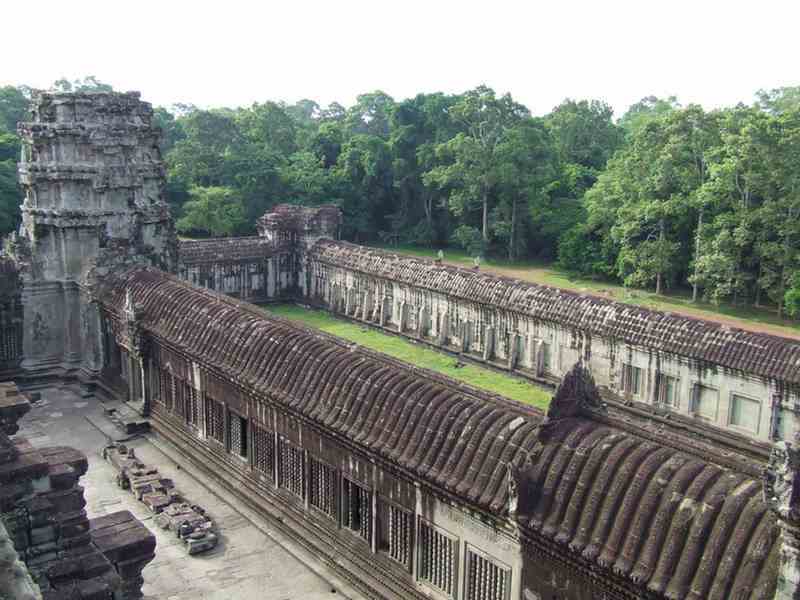
Angkor Thom, the last and most enduring capital city of the Khmer empire, is about 1.5 km north of Angkor Wat.
It was established in the late twelfth century, by king Jayavarman VII, as the capital of his empire,
and was the centre of his massive building programme.
One inscription found in the city refers to Jayavarman as the groom and the city as his bride.
Angkor Thom walls, 8 m high and flanked by a moat, are each 3 km long, enclosing an area of 9 km².
The walls are of laterite buttressed by earth, with a parapet on the top.
There are gates at each of the cardinal points,
from which roads lead to the Bayon at the centre of the city.
I had an elephant ride part of the way from Angkor Wat to Angkor Thom.
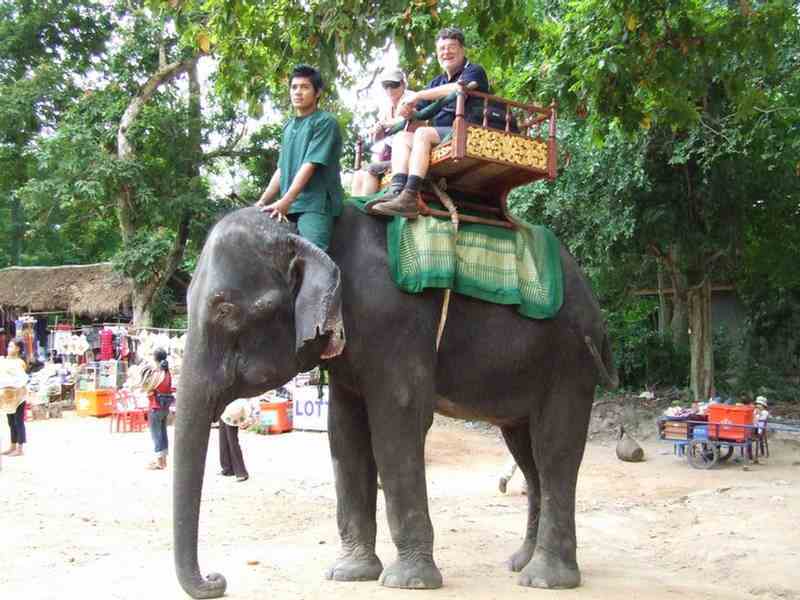
Preah Palilay
There are number of temples within the Angkor Thom complex.
Built in the 13th or 14th century, Preah Palilay is a Buddhist temple
(although with some Hindu imagery) in the Bayon style.
Its most distinctive feature is its chimney-shaped tower built of sandstone and laterite.
It is in a cool, pleaant, shaded forest setting.
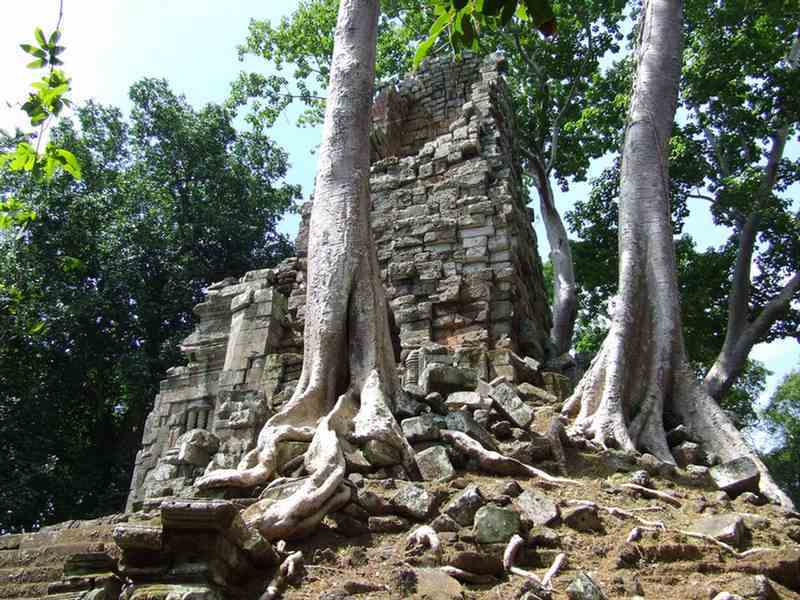
Phimeanakas
Phimeanakas ('celestial temple') is a laterite and sandstone temple, built at the end of the 10th century,
during the reign of Rajendravarman (from 941-968). It was later rebuilt by Suryavarman II
in the shape of a three tier pyramid as a Hindu temple.
On top of the pyramid there was a tower. According to legend,
the king spent the first watch of every night with a Naga girl in the tower,
during that time, not even the queen was permitted to intrude.
Only in the second watch the king returned to his palace with the queen.
If the naga who was the supreme land owner of Khmer land did not show up for a night,
the king's days would be numbered, if the king did not show up, calamity would strike his land.
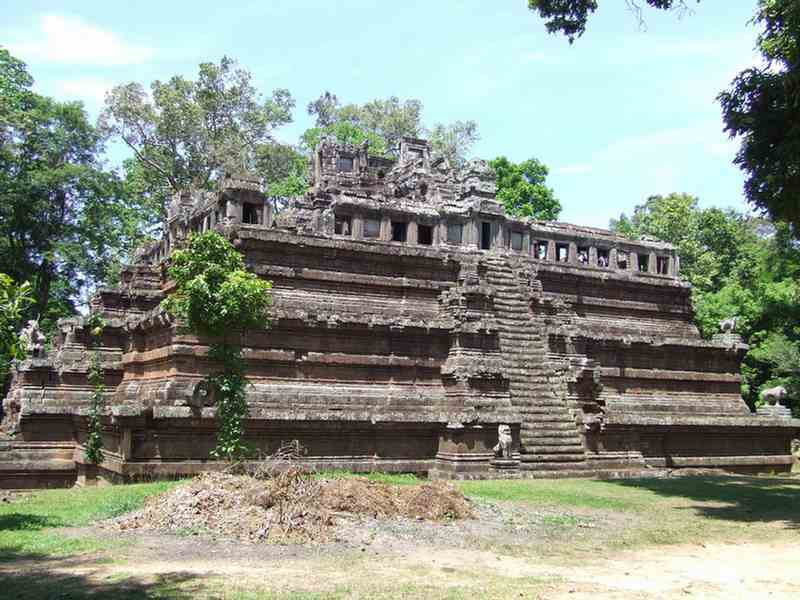
The Terrace of the Elephants
This very impressive 2.5m high, 350m long terrace is adorned with carved elephants. They are a great sight!!
The terrace was used by Jayavarman VII as a platform from which to view his victorious returning army,
parades, and other public ceremonies. It also served as a base for the king's grand audience hall.
It was originally topped with wooden pavillions decorated with golden-framed windows.
It is easy to imagine the overwhelming pomp and grandeur of the Khmer Empire
at its height in surroundings like this.
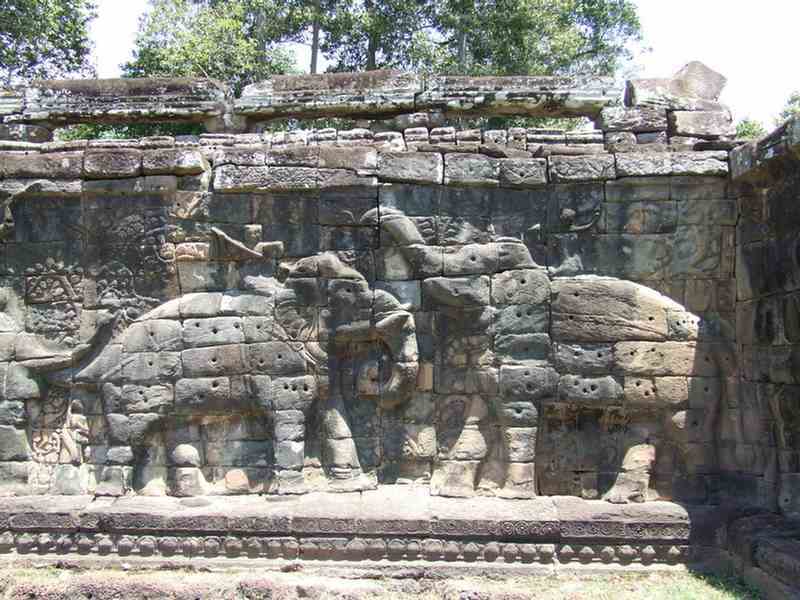
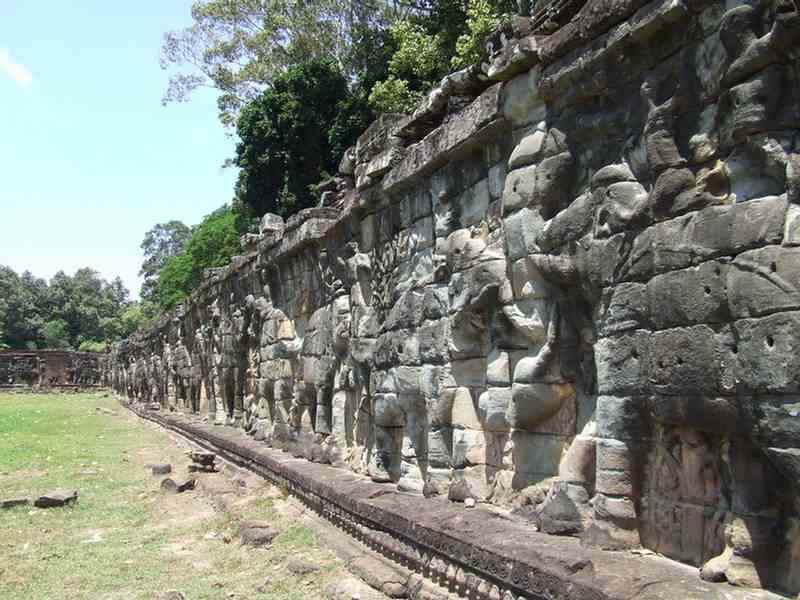
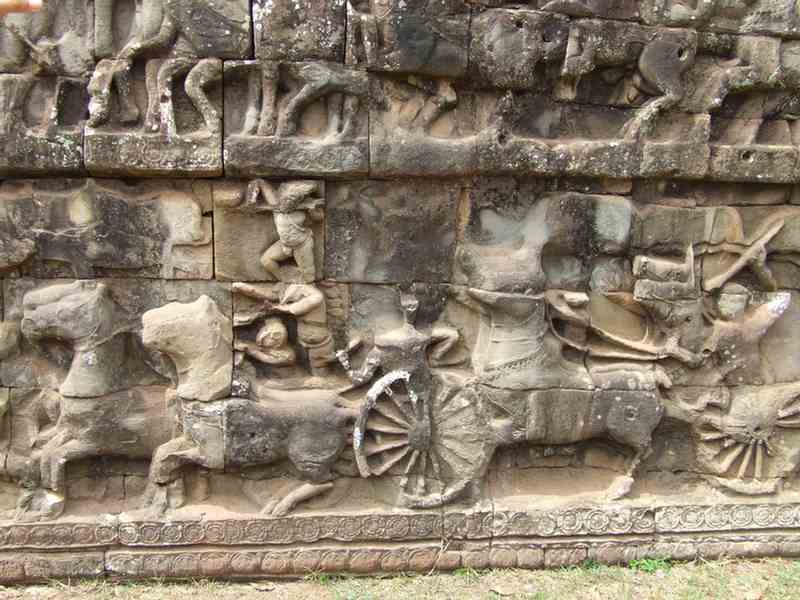
Bayon
The best temple at Angkor Thom was left to last to visit!!!
One of Angkor's most stunning temples, Bayon has 216 gargantuan faces of Avalokitesvara
(enlightened existence who embodies the compassion of all Buddhas) watching over visitors.
Built in the late 12th century or early 13th century as the official state temple of the Mahayana Buddhist
King Jayavarman VII, Bayon stands at the centre of Jayavarman's capital, Angkor Thom.
Following Jayavarman's death, it was modified and augmented by later Hindu and Theravada Buddhist kings
in accordance with their own religious preferences.
It has lots of bas-reliefs incorporating over 11,000 figures.
The Bayon was the last state temple to be built at Angkor, and the only one to be built primarily
as a Mahayana Buddhist temple dedicated to the Buddha.
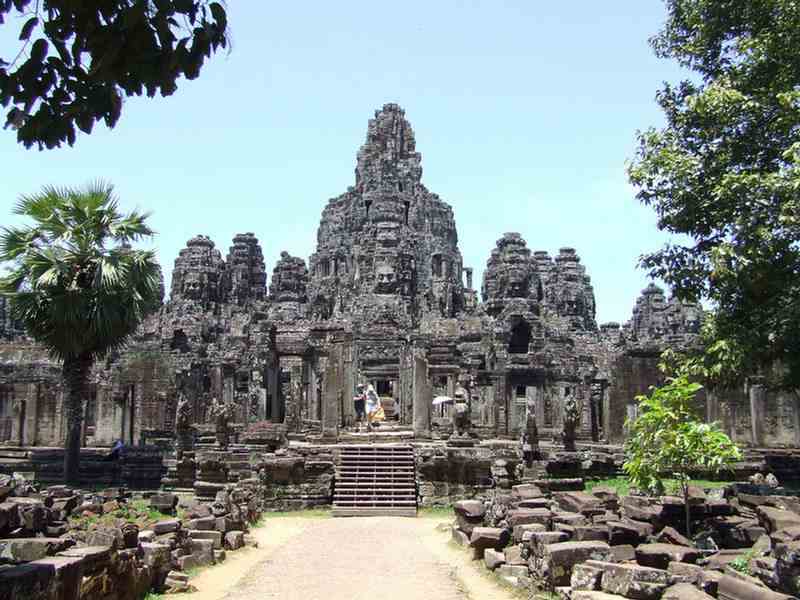
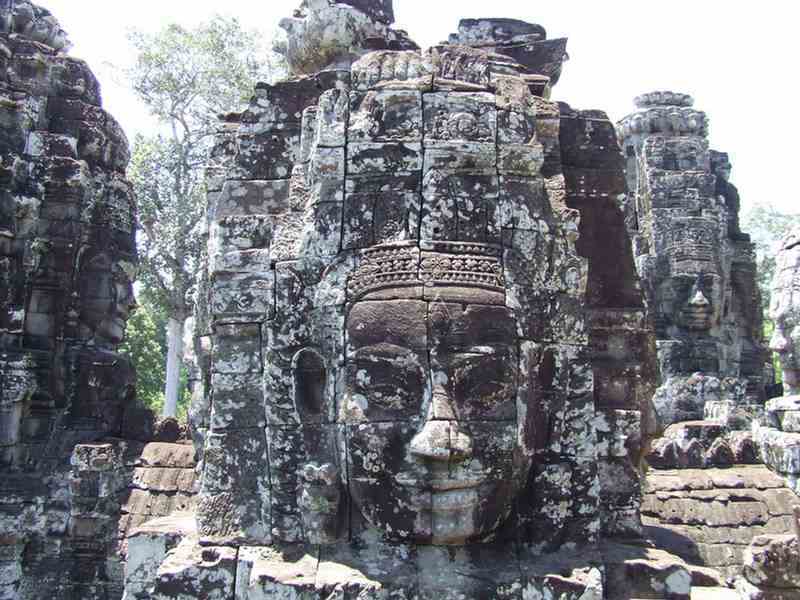
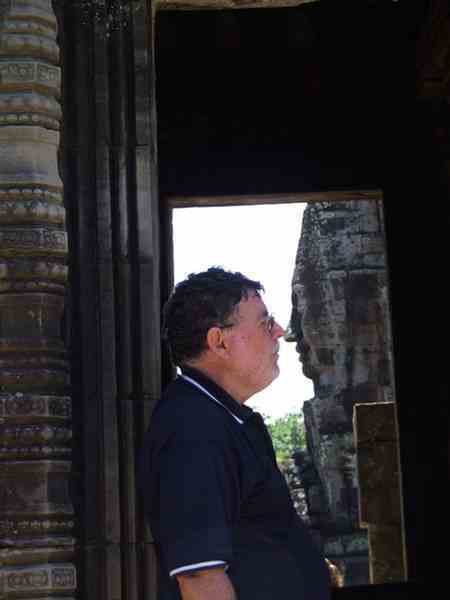
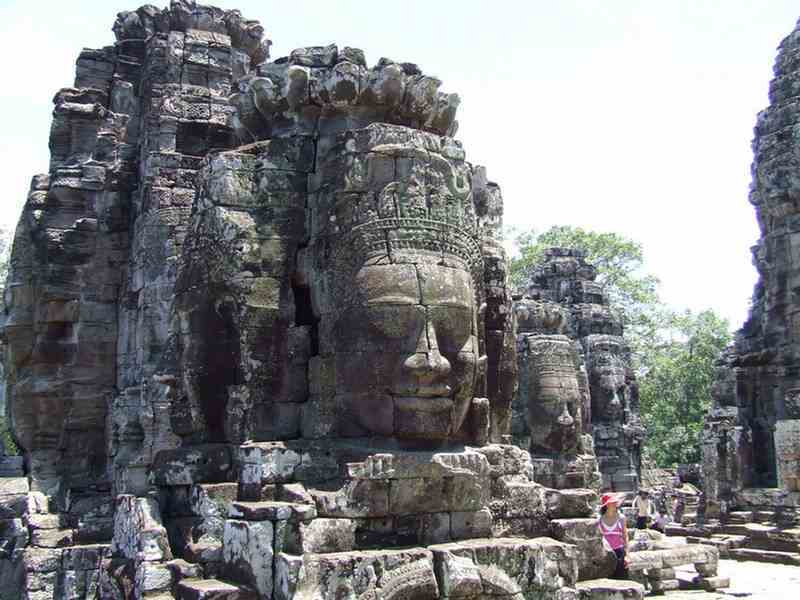
Reliefs depicting childbirth
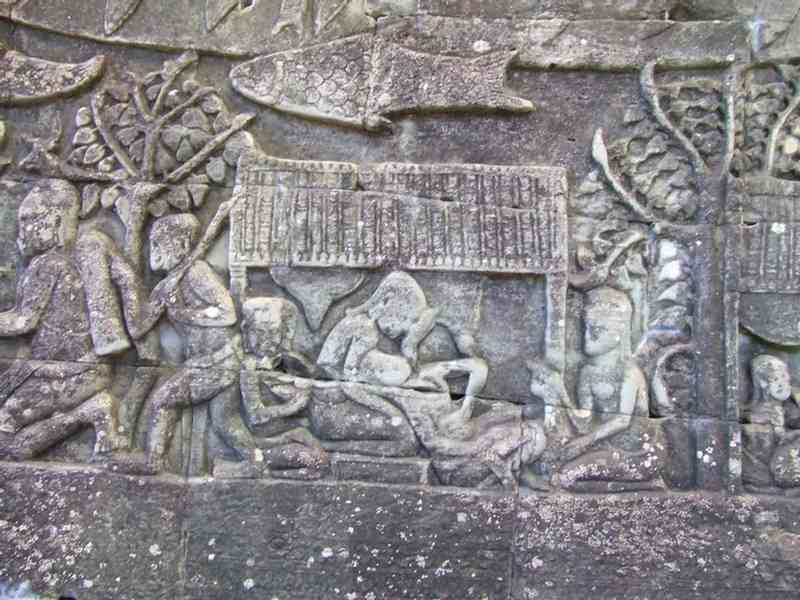
Ta Prohm ("The Jungle Temple")
Ta Prohm is the modern name of a temple built in the late 12th and
early 13th centuries and originally called Rajavihara.
Located 1km east of Angkor Thom, it was founded by the Khmer King Jayavarman VII as a
Mahayana Buddhist monastery and university.
Unlike most Angkorian temples, Ta Prohm has been left in much the same condition in which it was found.
The photogenic and atmospheric combination of trees growing out of the ruins and the jungle surroundings
have made it one of Angkor's most popular temples with visitors. It was my favourite.
After ascending the throne of Cambodia in 1181,
Jayavarman VII embarked on a massive program of construction and public works.
Rajavihara ("royal temple"), today known as Ta Prohm ("ancestor Brahma"),
was one of the first temples founded pursuant to that program.
The stele commemorating the foundation gives a date of 1186.
Jayavarman VII constructed Rajavihara in honor of his family.
The temple's stele records that the site was home to more than 12,500 people
(including 18 high priests and 615 dancers), with an additional 80,000 souls in the surrounding villages
working to provide services and supplies.
The stele also notes that the temple amassed considerable riches, including gold, pearls and silks.
After the fall of the Khmer empire in the 15th century,
the temple of Ta Prohm was abandoned and neglected for centuries.
When the effort to conserve and restore the temples of Angkor began in the early 20th century,
the École française d'Extrême-Orient decided that Ta Prohm would be left largely as it had been found,
as a "concession to the general taste for the picturesque."
It was singled out because it was "one of the most imposing [temples]
and the one which had best merged with the jungle,
but not yet to the point of becoming a part of it".
Nevertheless, much work has been done to stabilize the ruins, to permit access,
and to maintain "this condition of apparent neglect."
The trees growing out of the ruins are perhaps the most distinctive feature of Ta Prohm.
Two species predominate - the larger is the silk-cotton tree (Ceiba pentandra),
and the smaller is the strangler fig (Ficus gibbosa).
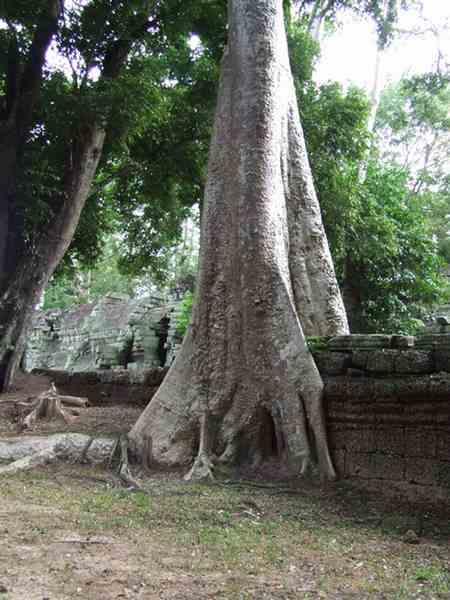
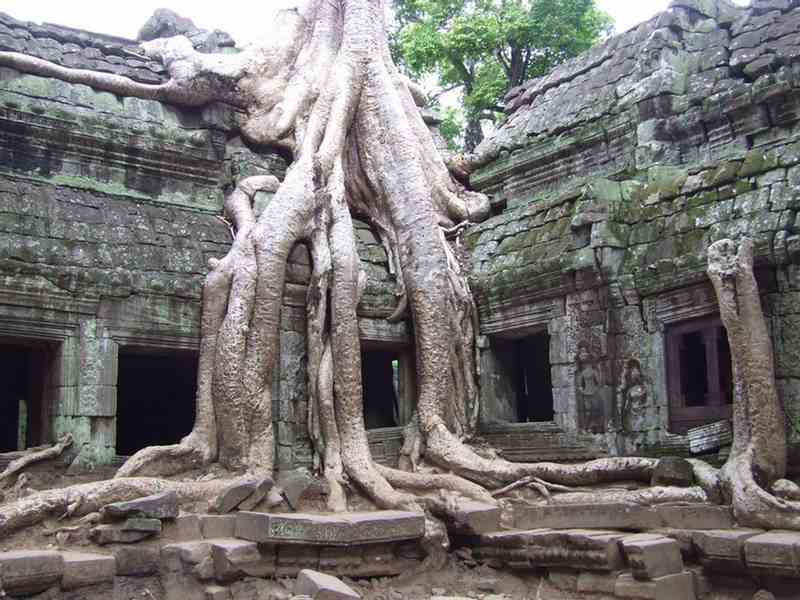
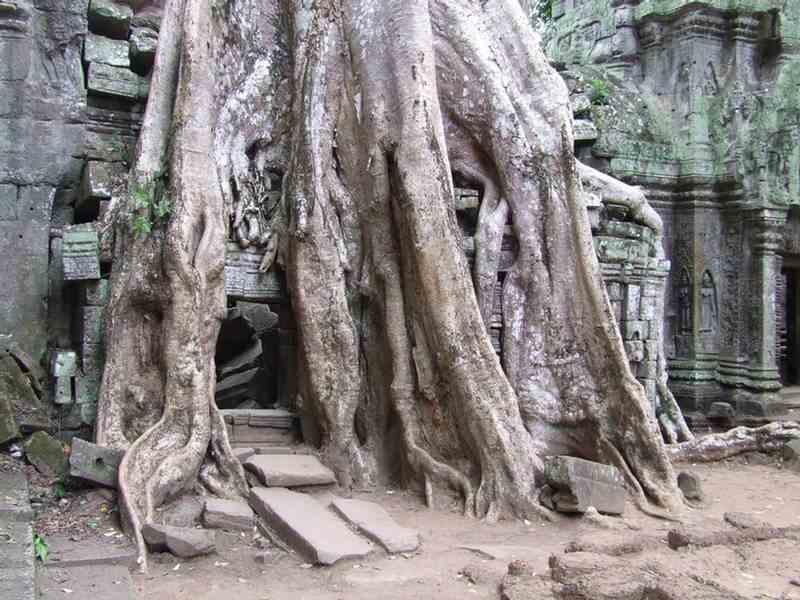
These trees are anywhere up to 500 years old now, around the same time that the temples were abandoned.
They have the consistency of a sponge and therefore don't inflict any great damage on the structures.
Scenes from the movies, Tomb Raider and Two Brothers were filmed at Ta Phrom.
If you can only visit one temple, this is the one.
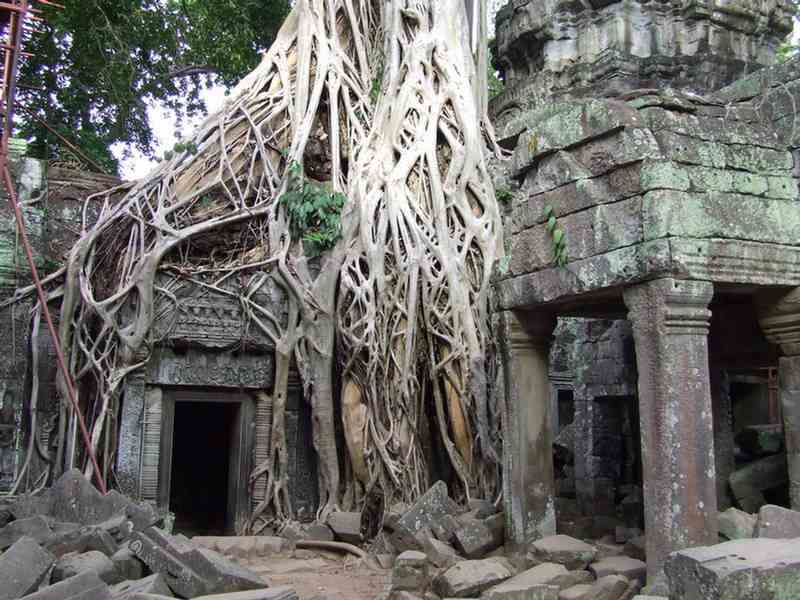
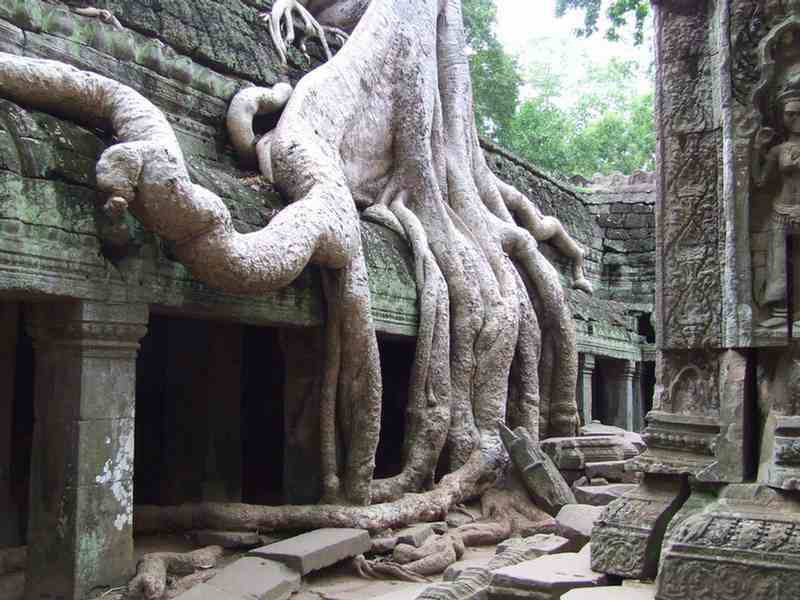
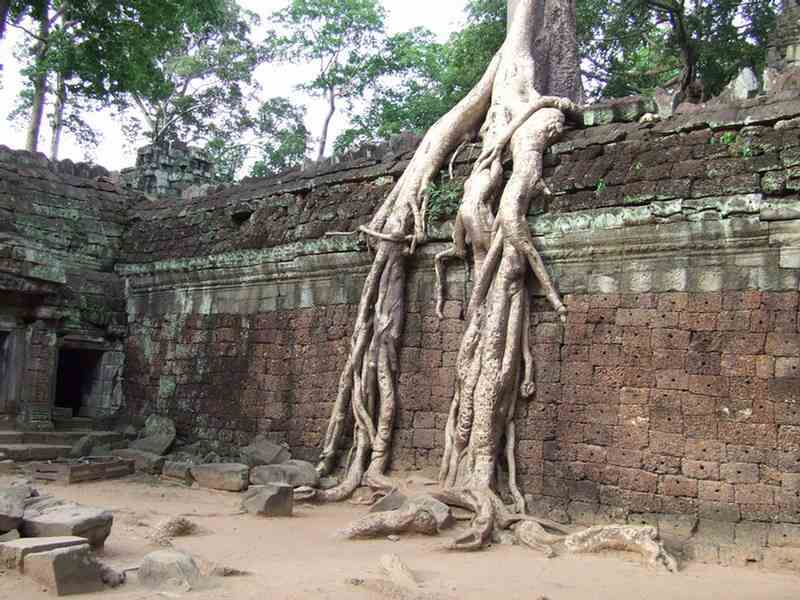
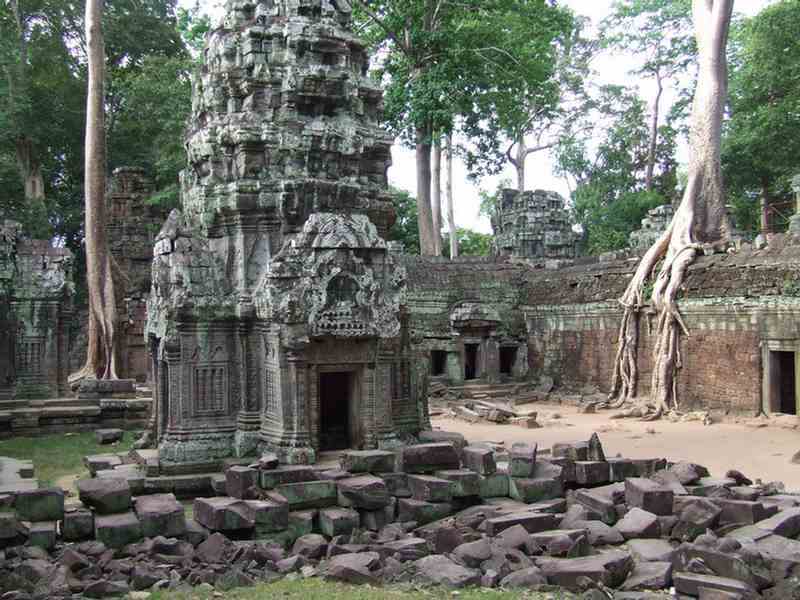
Pre Rup
Pre Rup was built as the state temple of King Rajendravarman and dedicated in 961 or 962.
Its extensive laterite and brick give it a pleasing reddish tone that is heightened
by early morning and late afternoon sunlight.
The temple’s name is a comparatively modern one meaning “turn the body."
This reflects the common belief among Cambodians that funerals were conducted at the temple,
with the ashes of the body being ritually rotated in different directions as the service progressed.
I came to see the sun set from Pre Rup.
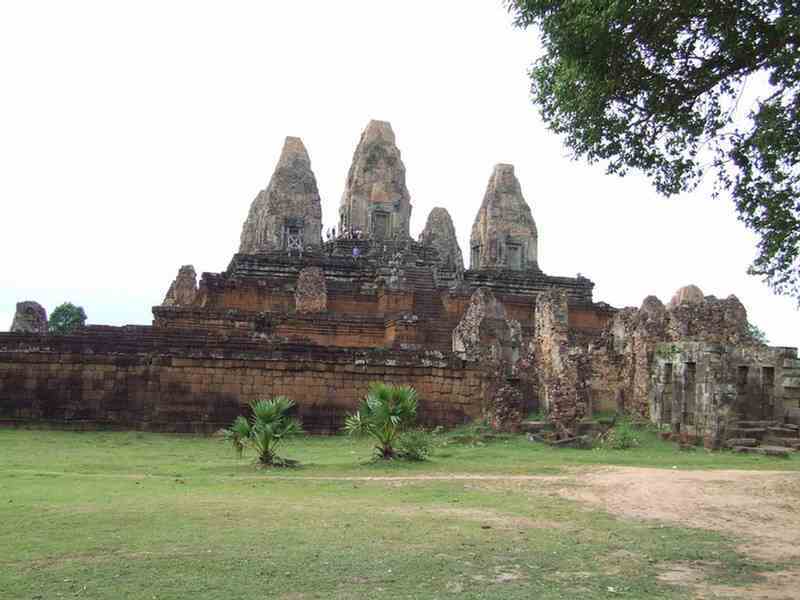
Banteay Srei
Banteay Srei (or Banteay Srey) is a 10th century temple dedicated to the Hindu god Shiva.
The temple's modern name, Banteay Srei (citadel of the women, or citadel of beauty),
is probably related to the intricacy of the bas relief carvings found on the walls
and the tiny dimensions of the buildings themselves.
Banteay Srei is built largely of red sandstone, a medium that lends itself to the elaborate
decorative wall carvings which are still easily observable today.
Banteay Srei was the only major temple at Angkor not built by a monarch.
Its construction is credited to a courtier named Yajnyavahara,
who served as a counsellor to king Rajendravarman.
The foundational stela says that Yajnyavahara was a scholar and philanthropist who helped those
who suffered from illness, injustice, or poverty.
The temple was discovered rather late, in 1914, by French archaelogists.
We came here in the morning as that is when the light is the best to view it.
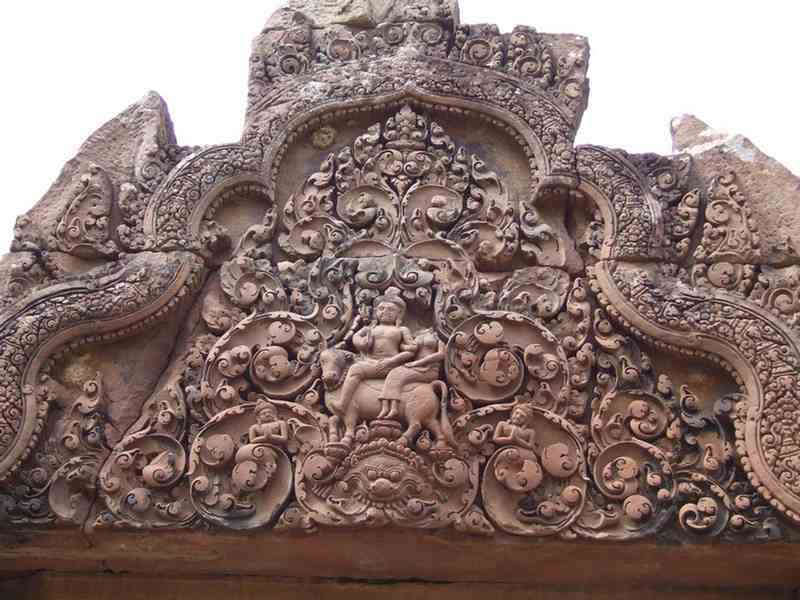
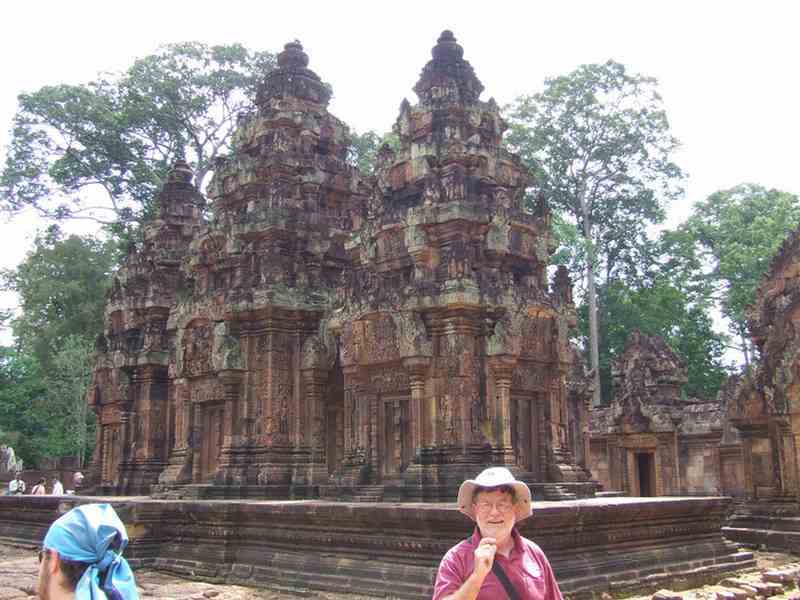
Preah Khan
Preah Khan was built on the site of Jayavarman VII's victory over the invading Chams in 1191. The modern name,
meaning "holy sword", is derived from the meaning of the original — Nagara Jayasri (holy city of victory).
It is a large complex. The walls surround a 1 km square area.
The institution combined the roles of city, temple and Buddhist university. There were over 1000 monks as well
as a vast number of attendants and servants, including 1000 dancers and 1000 teachers.
The temple is still largely unrestored. The site is maintained by the World Monuments Fund.
It has adopted a cautious approach to restoration,
believing that to go further would involve too much guesswork,
and prefers to respect the ruined nature of the temple.
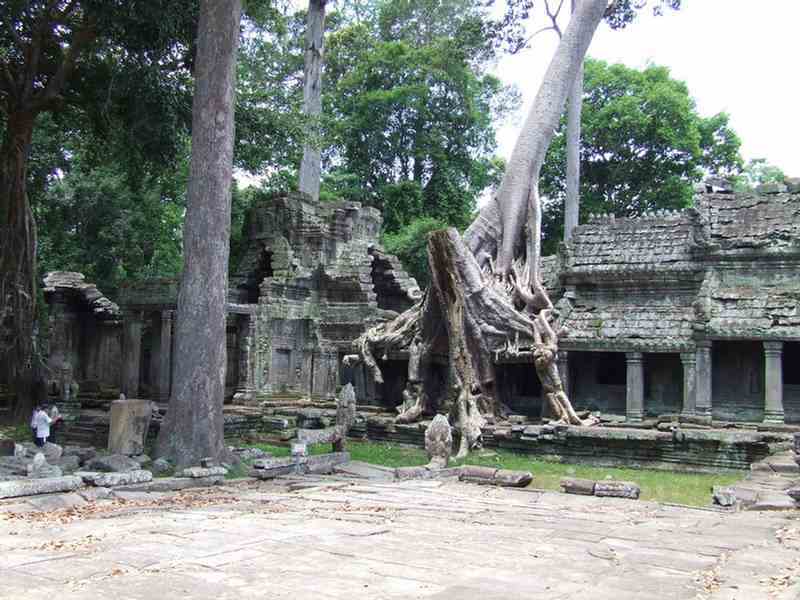
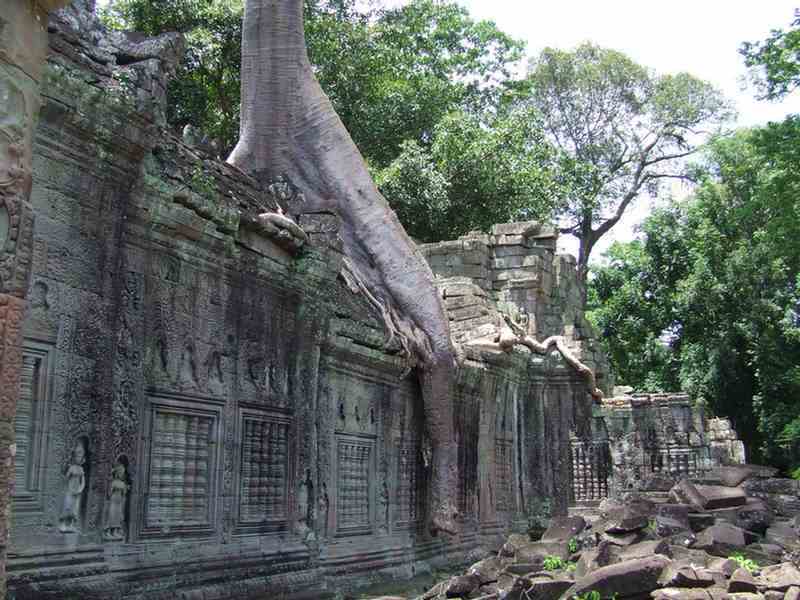
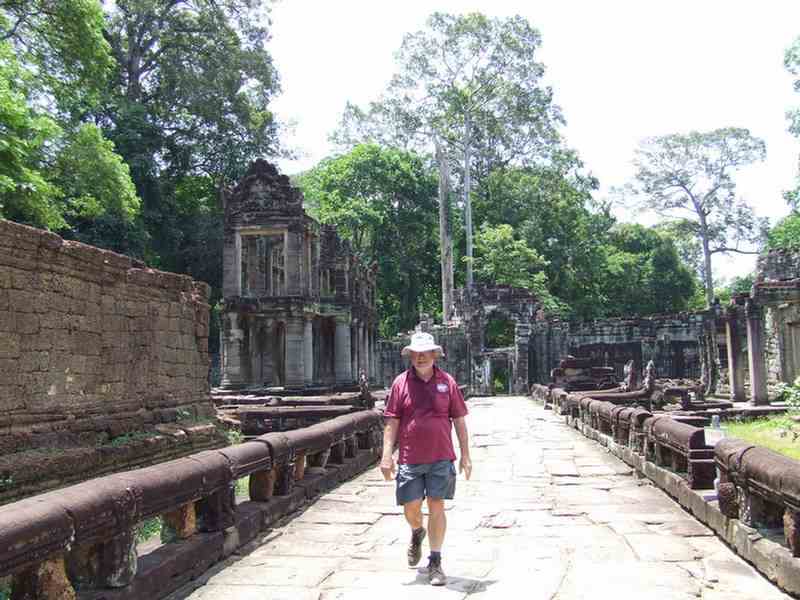
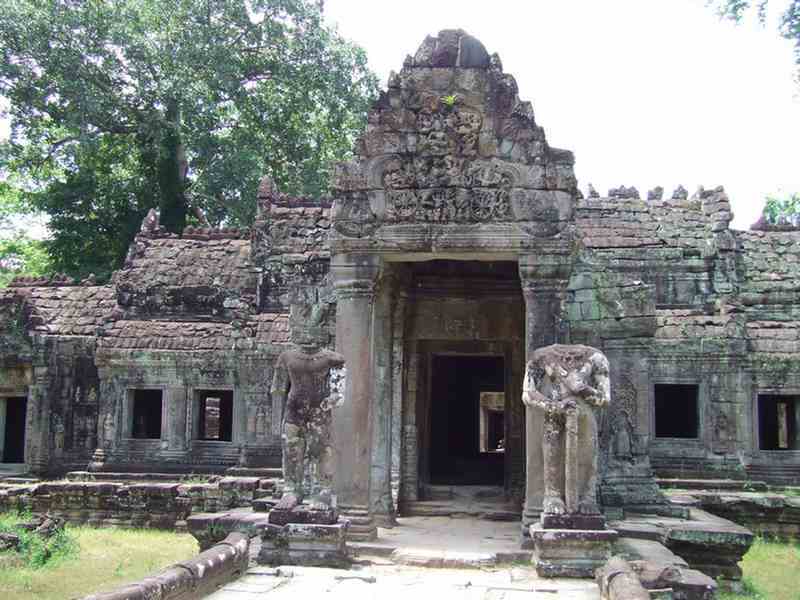
Lolei Temple
I took a tuk-tuk to the Roluos Group of Temples, about 15km from Siem Reap.
Some 70 years after Jayavarman II established his capital on Mount Kulen in 802 inaugurating the Angkor Period,
the king moved the king moved the capital to Hariharalaya (the abode of Hari-hara),
perhaps for a better source of food or for defence purposes. He died at Roluos in 850.
It served as the capital of Indravarman I (877 - 89).
It is generally believed that his successors remained there until the capital was moved to Bakheng in 905.
The temples here are among the earlist stone temples built by the Khmer
and mark the the beginning of classical art.
Firstly to Lolei Temple.
Lolei consists of 4 brick towers on a double laterite platform.
Once located in the middle of an artificial lake (now rice fields), the four brick towers are in poor condition.
There are Sanskrit inscriptions on the doorposts.
According to one of the inscriptions, the four towers were dedicated by Yasovarman I to his mother,
his father and his maternal grandparents on 12 July 893.

Preah Ko Temple
The second temple in the Rouos Group that I visted was Preah Ko Temple.
It was built in 879 by Indravarman I in honor of his ancestors.
Known as the temple of the sacred ox and dedicated to the Hindu god Shiva,
it features three sacred oxen in front of the first row of temples, all in poor condition.
It is a small temple with a single central tower surrounded by 2 laterite walls.
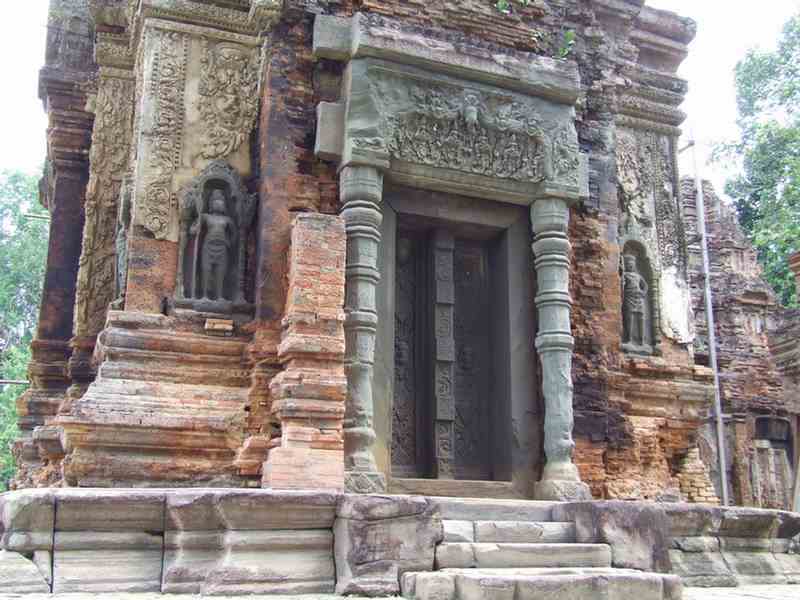
Bakong Temple
The last of the 3 temples in the Rolous Group that I visited.
The central temple built by Indravarman I, in 880, one year after Preah Ko, is an example of sandstone
mountain-temples. The five superimposed terraces symbolize Mount Meru.
'Discovered' by Henri-Marchal in 1936, the temple has been completely restored stone by stone.
It's the nicest of the Roluos temples as are its picturesque moat and vegetation surroundings.
The temple displays a very early use of stone rather than brick.
It was Indravarman's "baby".
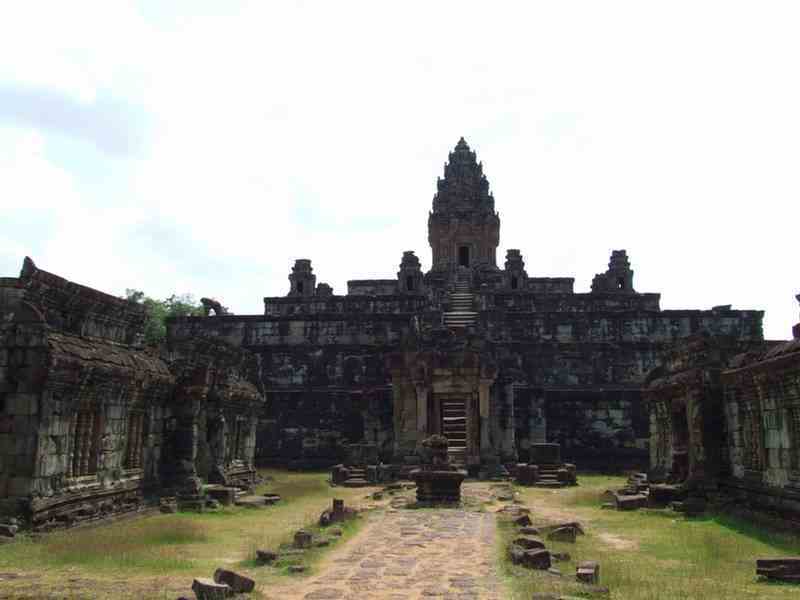
(Cambodia)
Some pictures from my trip to Indochina in June 2007
Angkor Wat is the largest religious building in the world.
It was built for King Suryavarman II in the early 12th century as his state temple and capital city.
As the best-preserved temple at the site, it is the only one to have remained a significant religious centre
since its foundation—first Hindu, dedicated to Vishnu, then Buddhist.
The temple is the epitome of the high classical style of Khmer architecture.
It has become a symbol of Cambodia, appearing on its national flag,
and it is the country's prime attraction for visitors.
Angkor Wat combines two basic plans of Khmer temple architecture
- the temple mountain and the later galleried temple.
It is designed to represent Mount Meru, home of the gods in Hindu mythology.
Within a moat and an outer wall 3.6 km long are three rectangular galleries, each raised above the next.
I got up at 4.30am in order see the sunrise at Angkor Wat.
I walked acrosss the causeway over the moat in the dark.
It was a great sight seeing Angkor Wat emerge from the darkness.
There were lots of tourists up early too.

In the 14th or 15th century the temple was converted to Theravada Buddhist use, which continues to the present day.
Angkor Wat is unusual among the Angkor temples in that although it was somewhat neglected after the 16th century
it was never completely abandoned, its preservation being due in part to the fact that its moat also provided some
protection from encroachment by the jungle.
Angkor Wat is the prime example of the classical style of Khmer architecture
(the Angkor Wat style) to which it has given its name.
By the 12th century Khmer architects had become skilled and confident in the use of sandstone
(rather than brick or laterite) as the main building material.
Most of the visible areas are of sandstone blocks, while laterite was used for the
outer wall and for hidden structural parts.
The binding agent used to join the blocks is yet to be identified,
although natural resins or slaked lime have been suggested.
The towers are shaped like lotus buds. The temple stands on a terrace raised higher than the surroundings.
The central tower rises 31m above the third level and 55m above the ground.
I was able to climb to the third level.
The very steep stairways represent the difficulty of ascending to the kingdom of the gods.

There are lots of galleries of sculptures on the walls.
The sculptures depict battles and scenes from daily life.


There are nearly 2000 distinctively rendered apsara carvings
(Hindu female spirit of the clouds and waters).

During half-millennia of Khmer occupation, the city of Angkor became a pilgrimage destination
of importance throughout Southeastern Asia.
Sacked by the Thais in 1431 and abandoned in 1432, Angkor was forgotten for a few centuries.
Wandering Buddhist monks, passing through the dense jungles, occasionally came upon the awesome ruins.
Recognizing the sacred nature of the temples but ignorant of their origins,
they invented fables about the mysterious sanctuaries,
saying they had been built by the gods in a far ancient time.
Centuries passed, these fables became legends,
and pilgrims from the distant reaches of Asia sought out the mystic city of the gods.
A few adventurous European travellers knew of the ruins and stories circulated in
antiquarian circles of a strange city lost in the jungles.
Most people believed the stories to be nothing more than legend however,
until the French explorer Henri Mouhot brought Angkor to the world's attention in 1860.
The French people were enchanted with the ancient city and beginning in 1908
funded and superbly managed an extensive restoration project.
The restoration has continued to the present day, excepting periods in the 70's and 80's
when military fighting prevented archaeologists from living near the ruins.

Angkor Thom, the last and most enduring capital city of the Khmer empire, is about 1.5 km north of Angkor Wat.
It was established in the late twelfth century, by king Jayavarman VII, as the capital of his empire,
and was the centre of his massive building programme.
One inscription found in the city refers to Jayavarman as the groom and the city as his bride.
Angkor Thom walls, 8 m high and flanked by a moat, are each 3 km long, enclosing an area of 9 km².
The walls are of laterite buttressed by earth, with a parapet on the top.
There are gates at each of the cardinal points,
from which roads lead to the Bayon at the centre of the city.
I had an elephant ride part of the way from Angkor Wat to Angkor Thom.

Preah Palilay
There are number of temples within the Angkor Thom complex.
Built in the 13th or 14th century, Preah Palilay is a Buddhist temple
(although with some Hindu imagery) in the Bayon style.
Its most distinctive feature is its chimney-shaped tower built of sandstone and laterite.
It is in a cool, pleaant, shaded forest setting.

Phimeanakas
Phimeanakas ('celestial temple') is a laterite and sandstone temple, built at the end of the 10th century,
during the reign of Rajendravarman (from 941-968). It was later rebuilt by Suryavarman II
in the shape of a three tier pyramid as a Hindu temple.
On top of the pyramid there was a tower. According to legend,
the king spent the first watch of every night with a Naga girl in the tower,
during that time, not even the queen was permitted to intrude.
Only in the second watch the king returned to his palace with the queen.
If the naga who was the supreme land owner of Khmer land did not show up for a night,
the king's days would be numbered, if the king did not show up, calamity would strike his land.

The Terrace of the Elephants
This very impressive 2.5m high, 350m long terrace is adorned with carved elephants. They are a great sight!!
The terrace was used by Jayavarman VII as a platform from which to view his victorious returning army,
parades, and other public ceremonies. It also served as a base for the king's grand audience hall.
It was originally topped with wooden pavillions decorated with golden-framed windows.
It is easy to imagine the overwhelming pomp and grandeur of the Khmer Empire
at its height in surroundings like this.



Bayon
The best temple at Angkor Thom was left to last to visit!!!
One of Angkor's most stunning temples, Bayon has 216 gargantuan faces of Avalokitesvara
(enlightened existence who embodies the compassion of all Buddhas) watching over visitors.
Built in the late 12th century or early 13th century as the official state temple of the Mahayana Buddhist
King Jayavarman VII, Bayon stands at the centre of Jayavarman's capital, Angkor Thom.
Following Jayavarman's death, it was modified and augmented by later Hindu and Theravada Buddhist kings
in accordance with their own religious preferences.
It has lots of bas-reliefs incorporating over 11,000 figures.
The Bayon was the last state temple to be built at Angkor, and the only one to be built primarily
as a Mahayana Buddhist temple dedicated to the Buddha.




Reliefs depicting childbirth

Ta Prohm ("The Jungle Temple")
Ta Prohm is the modern name of a temple built in the late 12th and
early 13th centuries and originally called Rajavihara.
Located 1km east of Angkor Thom, it was founded by the Khmer King Jayavarman VII as a
Mahayana Buddhist monastery and university.
Unlike most Angkorian temples, Ta Prohm has been left in much the same condition in which it was found.
The photogenic and atmospheric combination of trees growing out of the ruins and the jungle surroundings
have made it one of Angkor's most popular temples with visitors. It was my favourite.
After ascending the throne of Cambodia in 1181,
Jayavarman VII embarked on a massive program of construction and public works.
Rajavihara ("royal temple"), today known as Ta Prohm ("ancestor Brahma"),
was one of the first temples founded pursuant to that program.
The stele commemorating the foundation gives a date of 1186.
Jayavarman VII constructed Rajavihara in honor of his family.
The temple's stele records that the site was home to more than 12,500 people
(including 18 high priests and 615 dancers), with an additional 80,000 souls in the surrounding villages
working to provide services and supplies.
The stele also notes that the temple amassed considerable riches, including gold, pearls and silks.
After the fall of the Khmer empire in the 15th century,
the temple of Ta Prohm was abandoned and neglected for centuries.
When the effort to conserve and restore the temples of Angkor began in the early 20th century,
the École française d'Extrême-Orient decided that Ta Prohm would be left largely as it had been found,
as a "concession to the general taste for the picturesque."
It was singled out because it was "one of the most imposing [temples]
and the one which had best merged with the jungle,
but not yet to the point of becoming a part of it".
Nevertheless, much work has been done to stabilize the ruins, to permit access,
and to maintain "this condition of apparent neglect."
The trees growing out of the ruins are perhaps the most distinctive feature of Ta Prohm.
Two species predominate - the larger is the silk-cotton tree (Ceiba pentandra),
and the smaller is the strangler fig (Ficus gibbosa).



These trees are anywhere up to 500 years old now, around the same time that the temples were abandoned.
They have the consistency of a sponge and therefore don't inflict any great damage on the structures.
Scenes from the movies, Tomb Raider and Two Brothers were filmed at Ta Phrom.
If you can only visit one temple, this is the one.




Pre Rup
Pre Rup was built as the state temple of King Rajendravarman and dedicated in 961 or 962.
Its extensive laterite and brick give it a pleasing reddish tone that is heightened
by early morning and late afternoon sunlight.
The temple’s name is a comparatively modern one meaning “turn the body."
This reflects the common belief among Cambodians that funerals were conducted at the temple,
with the ashes of the body being ritually rotated in different directions as the service progressed.
I came to see the sun set from Pre Rup.

Banteay Srei
Banteay Srei (or Banteay Srey) is a 10th century temple dedicated to the Hindu god Shiva.
The temple's modern name, Banteay Srei (citadel of the women, or citadel of beauty),
is probably related to the intricacy of the bas relief carvings found on the walls
and the tiny dimensions of the buildings themselves.
Banteay Srei is built largely of red sandstone, a medium that lends itself to the elaborate
decorative wall carvings which are still easily observable today.
Banteay Srei was the only major temple at Angkor not built by a monarch.
Its construction is credited to a courtier named Yajnyavahara,
who served as a counsellor to king Rajendravarman.
The foundational stela says that Yajnyavahara was a scholar and philanthropist who helped those
who suffered from illness, injustice, or poverty.
The temple was discovered rather late, in 1914, by French archaelogists.
We came here in the morning as that is when the light is the best to view it.


Preah Khan
Preah Khan was built on the site of Jayavarman VII's victory over the invading Chams in 1191. The modern name,
meaning "holy sword", is derived from the meaning of the original — Nagara Jayasri (holy city of victory).
It is a large complex. The walls surround a 1 km square area.
The institution combined the roles of city, temple and Buddhist university. There were over 1000 monks as well
as a vast number of attendants and servants, including 1000 dancers and 1000 teachers.
The temple is still largely unrestored. The site is maintained by the World Monuments Fund.
It has adopted a cautious approach to restoration,
believing that to go further would involve too much guesswork,
and prefers to respect the ruined nature of the temple.




Lolei Temple
I took a tuk-tuk to the Roluos Group of Temples, about 15km from Siem Reap.
Some 70 years after Jayavarman II established his capital on Mount Kulen in 802 inaugurating the Angkor Period,
the king moved the king moved the capital to Hariharalaya (the abode of Hari-hara),
perhaps for a better source of food or for defence purposes. He died at Roluos in 850.
It served as the capital of Indravarman I (877 - 89).
It is generally believed that his successors remained there until the capital was moved to Bakheng in 905.
The temples here are among the earlist stone temples built by the Khmer
and mark the the beginning of classical art.
Firstly to Lolei Temple.
Lolei consists of 4 brick towers on a double laterite platform.
Once located in the middle of an artificial lake (now rice fields), the four brick towers are in poor condition.
There are Sanskrit inscriptions on the doorposts.
According to one of the inscriptions, the four towers were dedicated by Yasovarman I to his mother,
his father and his maternal grandparents on 12 July 893.

Preah Ko Temple
The second temple in the Rouos Group that I visted was Preah Ko Temple.
It was built in 879 by Indravarman I in honor of his ancestors.
Known as the temple of the sacred ox and dedicated to the Hindu god Shiva,
it features three sacred oxen in front of the first row of temples, all in poor condition.
It is a small temple with a single central tower surrounded by 2 laterite walls.

Bakong Temple
The last of the 3 temples in the Rolous Group that I visited.
The central temple built by Indravarman I, in 880, one year after Preah Ko, is an example of sandstone
mountain-temples. The five superimposed terraces symbolize Mount Meru.
'Discovered' by Henri-Marchal in 1936, the temple has been completely restored stone by stone.
It's the nicest of the Roluos temples as are its picturesque moat and vegetation surroundings.
The temple displays a very early use of stone rather than brick.
It was Indravarman's "baby".
